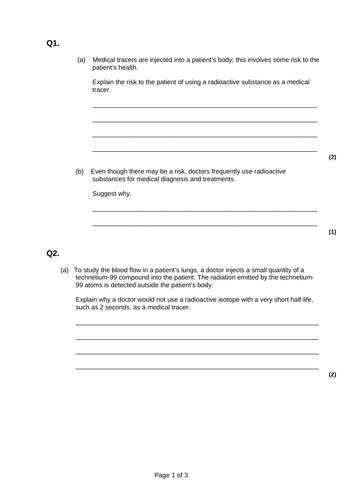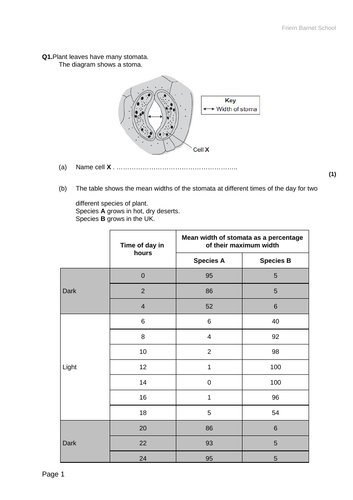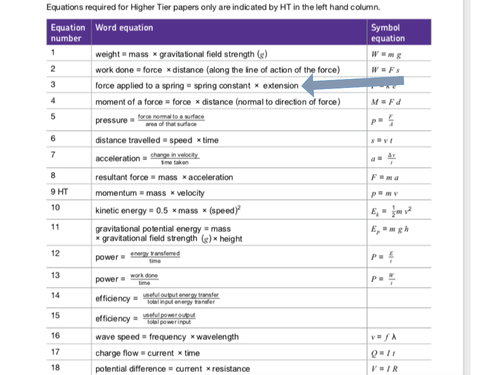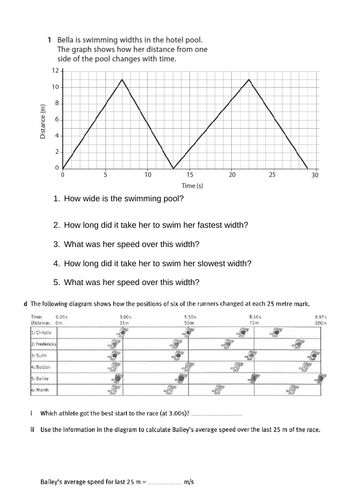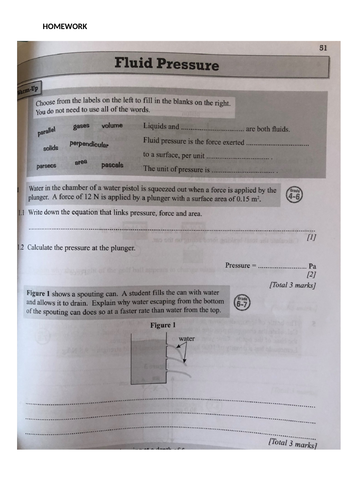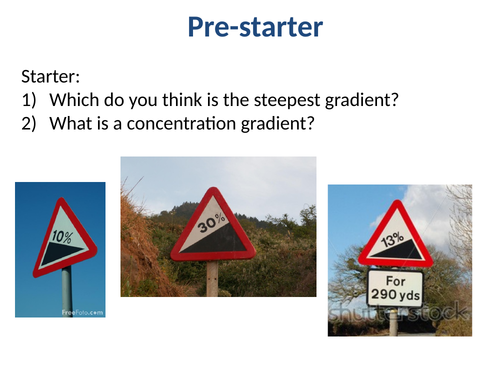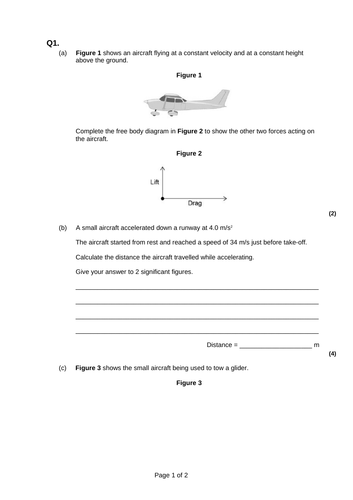172Uploads
30k+Views
2k+Downloads
All resources

AQA GCSE Physics Unit 1 (P1): Particle Model of Matter - Density Required Practical L5
This lesson is for teaching the above named lesson as part of the Particle Model of Matter Module of Physics Unit 1 (P1) of the new 2018 AQA GCSE specification for GCSE Physics.
The lesson has the following features embedded:
Lesson has Bloom’s Taxonomy embedded throughout which are also graded for differentiation.
Stretch and challenge
AfL (progress checks embedded)
Narrative of lesson structure is clear and focused as well as engaging.
Pre-starter prepared.
The lesson is geared with top-down approach pedagogy and provide inclusive differentiation for low attaining and medium attaining pupils as well.
The lesson should be ‘tweaked’ to meet the needs of your own pupils.

AQA GCSE Physics Unit 1 (P1): Atomic Structure - Nuclear Radiation in Medicine L6
This lesson is for teaching the above named lesson as part of the Atomic Structure Module of Physics Unit 1 (P1) of the new 2018 AQA GCSE specification for GCSE Physics.
The lesson has the following features embedded:
Lesson has Bloom’s Taxonomy embedded throughout which are also graded for differentiation.
Stretch and challenge
AfL (progress checks embedded)
Narrative of lesson structure is clear and focused as well as engaging.
Pre-starter prepared.
The lesson is geared with top-down approach pedagogy and provide inclusive differentiation for low attaining and medium attaining pupils as well.
The lesson should be ‘tweaked’ to meet the needs of your own pupils.

AQA GCSE Physics Unit 1 (P1): Electricity Module - Series and Parallel Circuits L1
This lesson is for teaching the above named lesson as part of the Electricity Module of Physics Unit 1 (P1) of the new 2018 AQA GCSE specification for GCSE Physics.
The lesson has the following features embedded:
Lesson has Bloom’s Taxonomy embedded throughout which are also graded for differentiation.
Stretch and challenge
AfL (progress checks embedded)
Narrative of lesson structure is clear and focused as well as engaging.
Pre-starter prepared.
The lesson is geared with top-down approach pedagogy and provide inclusive differentiation for low attaining and medium attaining pupils as well.
The lesson should be ‘tweaked’ to meet the needs of your own pupils.

2018 AQA GCSE Biology Unit 1 (B1): Blood Vessels L14
This lesson is for teaching the above named lesson as part of the Organisation module of Biology Unit 1 (B1) of the new 2018 AQA GCSE specifications for Combined Science: Trilogy and GCSE Biology.
The lesson has the following features embedded:
Lesson has Bloom’s Taxonomy embedded throughout which are also graded for differentiation.
Stretch and challenge tasks throughout (including Grade 8-9+ questions and extended writing)
AfL (3 progress checks embedded)
Differentiation is strong as has been noted in all formal school observations for the last 2 years of teaching AQA.
Narrative of lesson structure is clear and focused as well as engaging.
Pre-starter prepared.
The lesson is geared with top-down approach pedagogy and provide inclusive differentiation for low attaining and medium attaining pupils as well.
The lesson should be ‘tweaked’ to meet the needs of your own pupils.

2018 AQA GCSE Biology Unit 1 (B1): Transpiration L20
This lesson is for teaching the above named lesson as part of the Organisation module of Biology Unit 1 (B1) of the new 2018 AQA GCSE specifications for Combined Science: Trilogy and GCSE Biology.
The lesson has the following features embedded:
Lesson has Bloom’s Taxonomy embedded throughout which are also graded for differentiation.
Stretch and challenge tasks throughout (including Grade 8-9+ questions and extended writing)
AfL (3 progress checks embedded)
Differentiation is strong as has been noted in formal school observations for the last 2 years of teaching AQA.
Narrative of lesson structure is clear and focused as well as engaging.
Pre-starter prepared.
The lesson is geared with top-down approach pedagogy and provide inclusive differentiation for low attaining and medium attaining pupils as well.
The lesson should be ‘tweaked’ to meet the needs of your own pupils.

2018 AQA GCSE Biology Unit 1 (B1): Developing New Drugs L25
This lesson is for teaching the above named lesson as part of the Infection and Response module of Biology Unit 1 (B1) of the new 2018 AQA GCSE specifications for Combined Science: Trilogy and GCSE Biology.
The lesson has the following features embedded:
Lesson has Bloom’s Taxonomy embedded throughout which are also graded for differentiation.
Stretch and challenge tasks throughout (including Grade 8-9+ questions and extended writing)
AfL (3 progress checks embedded)
Differentiation is strong as has been noted in formal school observations for the last 2 years of teaching AQA.
Narrative of lesson structure is clear and focused as well as engaging.
Pre-starter prepared.
The lesson is geared with top-down approach pedagogy and provide inclusive differentiation for low attaining and medium attaining pupils as well.
The lesson should be ‘tweaked’ to meet the needs of your own pupils.

2018 AQA GCSE Biology Unit 1 (B1): The Response to Exercise L31
This lesson is for teaching the above named lesson as part of the Bioenergetics module of Biology Unit 1 (B1) of the new 2018 AQA GCSE specifications for Combined Science: Trilogy and GCSE Biology.
The lesson has the following features embedded:
Lesson has Bloom’s Taxonomy embedded throughout which are also graded for differentiation.
Stretch and challenge tasks throughout (including Grade 8-9+ questions and extended writing)
AfL (3 progress checks embedded)
Differentiation is strong as has been noted in formal school observations for the last 2 years of teaching AQA.
Narrative of lesson structure is clear and focused as well as engaging.
Pre-starter prepared.
The lesson is geared with top-down approach pedagogy and provide inclusive differentiation for low attaining and medium attaining pupils as well.
The lesson should be ‘tweaked’ to meet the needs of your own pupils.

AQA GCSE Physics Unit 1 (P1): Energy Module -Elastic Potential Energy L2
This lesson is for teaching the above named lesson as part of the Energy Module of Physics Unit 1 (P1) of the new 2018 AQA GCSE specification for GCSE Physics.
The lesson has the following features embedded:
Lesson has Bloom’s Taxonomy embedded throughout which are also graded for differentiation.
Stretch and challenge
AfL (progress checks embedded)
Narrative of lesson structure is clear and focused as well as engaging.
Pre-starter prepared.
The lesson is geared with top-down approach pedagogy and provide inclusive differentiation for low attaining and medium attaining pupils as well.
The lesson should be ‘tweaked’ to meet the needs of your own pupils.

AQA GCSE Physics Unit 2 (P2): Forces Module - More about Levers and Gears L9
This lesson is for teaching the above named lesson as part of the Forces Module of Physics Unit 2 (P2) of the new 2018 AQA GCSE specification for GCSE Physics.
The lesson has the following features embedded:
Lesson has Bloom’s Taxonomy embedded throughout which are also graded for differentiation.
Stretch and challenge
AfL (progress checks embedded)
Narrative of lesson structure is clear and focused as well as engaging.
Pre-starter prepared.
The lesson is geared with top-down approach pedagogy and provide inclusive differentiation for low attaining and medium attaining pupils as well.
The lesson should be ‘tweaked’ to meet the needs of your own pupils.

2018 AQA GCSE Biology Unit 1 (B1): Aerobic and Anaerobic Respiration L30
This lesson is for teaching the above named lesson as part of the Bioenergetics module of Biology Unit 1 (B1) of the new 2018 AQA GCSE specifications for Combined Science: Trilogy and GCSE Biology.
The lesson has the following features embedded:
Lesson has Bloom’s Taxonomy embedded throughout which are also graded for differentiation.
Stretch and challenge tasks throughout (including Grade 8-9+ questions and extended writing)
AfL (3 progress checks embedded)
Differentiation is strong as has been noted in formal school observations for the last 2 years of teaching AQA.
Narrative of lesson structure is clear and focused as well as engaging.
Pre-starter prepared.
The lesson is geared with top-down approach pedagogy and provide inclusive differentiation for low attaining and medium attaining pupils as well.
The lesson should be ‘tweaked’ to meet the needs of your own pupils.

AQA GCSE Physics Unit 2 (P2): Forces Module - Distance and Displacement L12
This lesson is for teaching the above named lesson as part of the Forces Module of Physics Unit 2 (P2) of the new 2018 AQA GCSE specification for GCSE Physics.
The lesson has the following features embedded:
Lesson has Bloom’s Taxonomy embedded throughout which are also graded for differentiation.
Stretch and challenge
AfL (progress checks embedded)
Narrative of lesson structure is clear and focused as well as engaging.
Pre-starter prepared.
The lesson is geared with top-down approach pedagogy and provide inclusive differentiation for low attaining and medium attaining pupils as well.
The lesson should be ‘tweaked’ to meet the needs of your own pupils.

AQA GCSE Physics Unit 2 (P2): Forces Module - Pressure in a Liquid at Rest L10
This lesson is for teaching the above named lesson as part of the Forces Module of Physics Unit 2 (P2) of the new 2018 AQA GCSE specification for GCSE Physics.
The lesson has the following features embedded:
Lesson has Bloom’s Taxonomy embedded throughout which are also graded for differentiation.
Stretch and challenge
AfL (progress checks embedded)
Narrative of lesson structure is clear and focused as well as engaging.
Pre-starter prepared.
The lesson is geared with top-down approach pedagogy and provide inclusive differentiation for low attaining and medium attaining pupils as well.
The lesson should be ‘tweaked’ to meet the needs of your own pupils.

AQA GCSE Physics Unit 2 (P2): Forces Module - Weight and Terminal Velocity L15
This lesson is for teaching the above named lesson as part of the Forces Module of Physics Unit 2 (P2) of the new 2018 AQA GCSE specification for GCSE Physics.
The lesson has the following features embedded:
Lesson has Bloom’s Taxonomy embedded throughout which are also graded for differentiation.
Stretch and challenge
AfL (progress checks embedded)
Narrative of lesson structure is clear and focused as well as engaging.
Pre-starter prepared.
The lesson is geared with top-down approach pedagogy and provide inclusive differentiation for low attaining and medium attaining pupils as well.
The lesson should be ‘tweaked’ to meet the needs of your own pupils.

2018 AQA GCSE Physics Unit 1 (P1): Specific Heat Capacity L5
This lesson is for teaching the above named lesson as part of the Energy module of Physics Unit 1 (P1) of the new 2018 AQA GCSE specifications for Combined Science: Trilogy and GCSE Physics.
The lesson has the following features embedded:
Lesson has Bloom’s Taxonomy embedded throughout which are also graded for differentiation.
Stretch and challenge tasks throughout (including Grade 8-9+ questions and extended writing)
AfL (3 progress checks embedded)
Differentiation is strong as has been noted in formal school observations for the last 2 years of teaching AQA.
Narrative of lesson structure is clear and focused as well as engaging.
Pre-starter prepared.
The lesson is geared with top-down approach pedagogy and provide inclusive differentiation for low attaining and medium attaining pupils as well.
The lesson should be ‘tweaked’ to meet the needs of your own pupils.
NB: This lesson should be taught before the Specific Heat Capacity GCSE Required Practical (L6) (can be purchased separately).

AQA GCSE Physics P1 Energy Module - Lesson 1
This lesson is for teaching the above named lesson as part of the Energy Module of Physics Unit 1 (P1) of the new 2018 AQA GCSE specification for GCSE Physics.
The lesson has the following features embedded:
Lesson has Bloom’s Taxonomy embedded throughout which are also graded for differentiation.
Stretch and challenge
AfL (progress checks embedded)
Narrative of lesson structure is clear and focused as well as engaging.
Pre-starter prepared.
The lesson is geared with top-down approach pedagogy and provide inclusive differentiation for low attaining and medium attaining pupils as well.
The lesson should be ‘tweaked’ to meet the needs of your own pupils.

AQA GCSE Physics Unit 1 (P1): Energy Module - Specific Heat Capacity Required Practical L7
This lesson is for teaching the above named lesson as part of the Energy Module of Physics Unit 1 (P1) of the new 2018 AQA GCSE specification for GCSE Physics.
The lesson has the following features embedded:
Lesson has Bloom’s Taxonomy embedded throughout which are also graded for differentiation.
Stretch and challenge
AfL (progress checks embedded)
Narrative of lesson structure is clear and focused as well as engaging.
Pre-starter prepared.
The lesson is geared with top-down approach pedagogy and provide inclusive differentiation for low attaining and medium attaining pupils as well.
The lesson should be ‘tweaked’ to meet the needs of your own pupils.

2018 AQA GCSE Biology Unit 1 (B1): Active Transport L8
This lesson is for teaching the above named lesson as part of the Cell Biology module of Biology Unit 1 (B1) of the new 2018 AQA GCSE specifications for Combined Science: Trilogy and GCSE Biology.
The lesson has the following features embedded:
Lesson has Bloom’s Taxonomy embedded throughout which are also graded for differentiation.
Stretch and challenge tasks throughout (including Grade 8-9+ questions and extended writing)
AfL (3 progress checks embedded)
Differentiation is strong as has been noted in all formal school observations for the last 2 years of teaching AQA.
Narrative of lesson structure is clear and focused as well as engaging.
Pre-starter prepared.
The lesson is geared with top-down approach pedagogy and provide inclusive differentiation for low attaining and medium attaining pupils as well.
The lesson should be ‘tweaked’ to meet the needs of your own pupils.

2018 AQA GCSE Physics Unit 1 (P1): Kinetic Energy L1
This lesson is for teaching the above named lesson as part of the Energy module of Physics Unit 1 (P1) of the new 2018 AQA GCSE specifications for Combined Science: Trilogy and GCSE Physics.
The lesson has the following features embedded:
Lesson has Bloom’s Taxonomy embedded throughout which are also graded for differentiation.
Stretch and challenge tasks throughout (including Grade 8-9+ questions and extended writing)
AfL (3 progress checks embedded)
Differentiation is strong as has been noted in formal school observations for the last 2 years of teaching AQA.
Narrative of lesson structure is clear and focused as well as engaging.
Pre-starter prepared.
The lesson is geared with top-down approach pedagogy and provide inclusive differentiation for low attaining and medium attaining pupils as well.
The lesson should be ‘tweaked’ to meet the needs of your own pupils.

AQA GCSE Physics Unit 1 (P1): Electricity Module - Electrical Circuits and Diagrams L2
This lesson is for teaching the above named lesson as part of the Electricity Module of Physics Unit 1 (P1) of the new 2018 AQA GCSE specification for GCSE Physics.
The lesson has the following features embedded:
Lesson has Bloom’s Taxonomy embedded throughout which are also graded for differentiation.
Stretch and challenge
AfL (progress checks embedded)
Narrative of lesson structure is clear and focused as well as engaging.
Pre-starter prepared.
The lesson is geared with top-down approach pedagogy and provide inclusive differentiation for low attaining and medium attaining pupils as well.
The lesson should be ‘tweaked’ to meet the needs of your own pupils.

AQA GCSE Physics Unit 1 (P1): Forces Module - Resolution of Forces L4
This lesson is for teaching the above named lesson as part of the Forces Module of Physics Unit 2 (P2) of the new 2018 AQA GCSE specification for GCSE Physics.
The lesson has the following features embedded:
Lesson has Bloom’s Taxonomy embedded throughout which are also graded for differentiation.
Stretch and challenge
AfL (progress checks embedded)
Narrative of lesson structure is clear and focused as well as engaging.
Pre-starter prepared.
The lesson is geared with top-down approach pedagogy and provide inclusive differentiation for low attaining and medium attaining pupils as well.
The lesson should be ‘tweaked’ to meet the needs of your own pupils.


